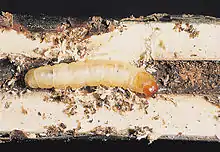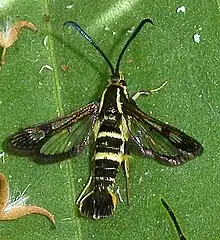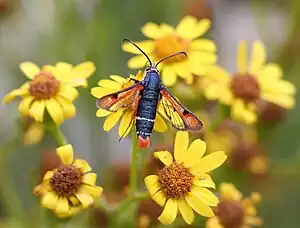Sesiidae
The Sesiidae or clearwing moths are a diurnal moth family in the order Lepidoptera known for their Batesian mimicry in both appearance and behaviour of various Hymenoptera.
| Sesiidae | |
|---|---|
 | |
| Synanthedon tipuliformis | |
| Scientific classification | |
| Domain: | Eukaryota |
| Kingdom: | Animalia |
| Phylum: | Arthropoda |
| Class: | Insecta |
| Order: | Lepidoptera |
| Superfamily: | Cossoidea |
| Family: | Sesiidae Boisduval, 1828 |
| Type species | |
| Sphinx apiformis Clerck, 1759 | |
| Subfamilies | |
| Diversity | |
| 165 genera 1,525 species | |
| Synonyms | |
| |

The family consists of 165 genera spread over two subfamilies, containing in total 1525 species and 49 subspecies,[1] most of which occur in the tropics, though there are many species in the Holarctic region as well, including over a hundred species known to occur in Europe.[2]: Backcover, 6
Morphology
Sesiidae are characterized by their hymenopteriform[lower-alpha 1] Batesian mimicry, frequently of identifiable species.[2]: 11, 16 Most species of Sesiidae have wings with areas where scales are nearly completely absent, resulting in partial, marked transparency.[2]: 11 Forewings are commonly elongated and narrow in the basal half.[2]: 11 In many species, the abdomen is elongated, with an anal tuft, and striped or ringed yellow, red or white,[2]: 11 sometimes very brightly so. Legs are long, thin and frequently coloured,[2]: 11 and in some species the hind-legs are elongated.[3] In European species, the wing span ranges from 8 to 48 mm.[2]: 11
Larvae lack pigment. Segments of the thorax are somewhat enlarged.[2]: 11
Behaviour
The larvae of the Sesiidae typically bore in wood or burrow in plant roots. Many species are serious pests of fruit-tree or timber cultivation, or crop plants (e.g. Melittia spp. on squash) (Edwards et al., 1999). Larval development lasts 1–4 years, pupal stage 10–20 days.[2]: 16
Adults are diurnally active.[3][2]: 16 Movements, including flight, mimic those of Hymenoptera spp.[2]: 16 Specimens are commonly collected using pheromone lures.[3][2]: 22
Taxonomy
- Subfamily Tinthiinae Le Cerf, 1917
- Tribe Tinthiini Le Cerf, 1917
- Microsphecia Bartel, 1912
- Tinthia Walker, [1865]
- Sophona Walker, 1856
- Zenodoxus Grote & Robinson, 1868
- Conopsia Strand, [1913]
- Paranthrenopsis Le Cerf, 1911
- Entrichella Bryk, 1947
- Negotinthia Gorbunov, 2001
- Trichocerota Hampson, [1893]
- Paradoxecia Hampson, 1919
- Rectala Bryk, 1947
- Ceratocorema Hampson, [1893]
- Caudicornia Bryk, 1947
- Bidentotinthia Arita & Gorbunov, 2003
- Tarsotinthia Arita & Gorbunov, 2003
- Tyrictaca Walker, 1862
- Tribe Pennisetiini Naumann, 1971
- Pennisetia Dehne, 1850
- Corematosetia Kallies & Arita, 2001
- Tribe Paraglosseciini Gorbunov & Eitschberger 1990
- Oligophlebia Hampson, [1893]
- Isothamnis Meyrick, 1935
- Cyanophlebia Arita & Gorbunov, 2001
- Lophocnema Turner, 1917
- Diapyra Turner, 1917
- Micrecia Hampson, 1919
- Tribe Similipepsini Špatenka, Laštuvka, Gorbunov, Toševski & Arita, 1993
- Similipepsis Le Cerf, 1911
- Gasterostena Arita & Gorbunov, 2003
- Tribe Tinthiini Le Cerf, 1917
- Subfamily Sesiinae Boisduval, 1828
- Tribe Sesiini Boisduval, 1828
- Sesia Fabricius, 1775
- Trilochana Moore, 1879
- Cyanosesia Gorbunov & Arita, 1995
- Sphecosesia Hampson, 1910
- Teinotarsina Felder, 1874
- Lenyra Walker, 1856
- Aegerosphecia Le Cerf, 1916
- Lamellisphecia Kallies & Arita, 2004
- Clavigera Kallies & Arita, 2004
- Eusphecia Le Cerf, 1937
- Scasiba Matsumura, 1931
- Callisphecia Le Cerf, 1916
- Madasphecia Viette, 1982
- Melittosesia Bartsch, 2009
- Barbasphecia Pühringer & Sáfián 2011
- Afrokona Fischer, 2006
- Hovaesia Le Cerf, 1957
- Lenyrhova Le Cerf, 1957
- Tribe Cissuvorini Duckworth & Eichlin 1977
- Toleria Walker, [1865]
- Chimaerosphecia Strand, [1916]
- Glossosphecia Hampson, 1919
- Cissuvora Engelhardt, 1946
- Dasysphecia Hampson, 1919
- Tribe Osminiini Duckworth & Eichlin 1977
- Osminia Le Cerf, 1917
- Chamanthedon Le Cerf, 1916
- Microsynanthedon Viette, [1955]
- Calasesia Beutenmüller, 1899
- Aenigmina Le Cerf, 1912
- Cabomina de Freina, 2008
- Pyranthrene Hampson, 1919
- Homogyna Le Cerf, 1911
- Aschistophleps Hampson [1893]
- Pyrophleps Arita & Gorbunov, 2000
- Heterosphecia Le Cerf, 1916
- Melanosphecia Le Cerf, 1916
- Akaisphecia Gorbunov & Arita, 1995
- Callithia Le Cerf, 1916
- Tribe Melittiini Le Cerf, 1917
- Melittia Hübner, [1819]
- Desmopoda Felder, 1874
- Agriomelissa Meyrick, 1931
- Afromelittia Gorbunov & Arita, 1997
- Cephalomelittia Gorbunov & Arita, 1995
- Macroscelesia Hampson, 1919
- Tribe Paranthrenini Niculescu, 1964
- Nokona Matsumura 1931
- Taikona Arita & Gorbunov, 2001
- Scoliokona Kallies & Arita, 1998
- Rubukona Fischer, 2007
- Adixoa Hampson, [1893]
- Pramila Moore, 1879
- Vitacea Engelhardt, 1946
- Phlogothauma Butler, 1882
- Paranthrene Hübner, [1819]
- Pseudosesia Felder, 1861
- Albuna Edwards, 1881
- Euhagena Edwards, 1881
- Sincara Walker, 1856
- Tirista Walker, [1865]
- Thyranthrene Hampson, 1919
- Sura Walker, 1856
- Tribe Synanthedonini Niculescu, 1964
 Synanthedon sp.
Synanthedon sp.- Synanthedon Hübner, [1819]
- Ravitria Gorbunov & Arita, 2000
- Kantipuria Gorbunov & Arita, 1999
- Kemneriella Bryk, 1947
- Ichneumenoptera Hampson, [1893]
- Paranthrenella Strand, [1916]
- Anthedonella Gorbunov & Arita, 1999
- Schimia Gorbunov & Arita, 1999
- Uncothedon Gorbunov & Arita, 1999
- Palmia Beutenmüller, 1896
- Podosesia Möschler, 1879
- Sannina Walker, 1856
- Nyctaegeria Le Cerf, 1914
- Carmenta Edwards, 1881
- Penstemonia Engelhardt, 1946
- Camaegeria Strand, 1914
- Malgassesia Le Cerf, 1922
- Lophoceps Hampson, 1919
- Tipulamima Holland, 1893
- Rodolphia Le Cerf, 1911
- Alcathoe Edwards, 1882
- Pseudalcathoe Le Cerf, 1916
- Macrotarsipus Hampson, [1893]
- Grypopalpia Hampson, 1919
- Hymenoclea Engelhardt, 1946
- Euryphrissa Butler, 1874
- Leptaegeria Le Cerf, 1916
- Aegerina Le Cerf, 1917
- Stenosphecia Le Cerf, 1917
- Bembecia Hübner, [1819]
- Pyropteron Newman, 1832
 The fiery clearwing moth, Pyropteron chrysidiformis
The fiery clearwing moth, Pyropteron chrysidiformis - Dipchasphecia Capuse, 1973
- Chamaesphecia Spuler, 1910
- Weismanniola Naumann, 1971
- Ichneumonella Gorbunov & Arita, 2005
- Crinipus Hampson, 1896
- Genera unassigned to tribe
- Alonina Walker, 1856
- Anaudia Wallengren, 1863
- Augangela Meyrick, 1932
- Austrosetia Felder, 1874
- Ceritrypetes Bradley, 1956
- Conopyga Felder, 1861
- Echidgnathia Hampson, 1919
- Episannina Aurivillius, 1905
- Erismatica Meyrick, 1933
- Gymnosophistis Meyrick, 1934
- Hymenosphecia Le Cerf, 1917
- Isocylindra Meyrick, 1930
- Lepidopoda Hampson, 1900
- Leuthneria Dalla Torre, 1925
- Megalosphecia Le Cerf, 1916
- Melisophista Meyrick, 1927
- Metasphecia Le Cerf, 1917
- Mimocrypta Naumann, 1971
- Monopetalotaxis Wallengren, 1859
- Pedalonina Gaede, 1929
- Proaegeria Le Cerf, 1916
- Pseudomelittia Le Cerf, 1917
- Tradescanticola Hampson, 1919
- Uranothyris Meyrick, 1933
- Vespanthedon Le Cerf, 1917
- Xenoses Durrant, 1924
- Zhuosesia Yang, 1977
- Tribe Sesiini Boisduval, 1828
References
- Hymenoptera + form: having the appearance of Hymenoptera species, such as wasps and hornets
- Pühringer, Franz (10 October 2021). "Checklist of the Sesiidae of the world (Lepidoptera: Ditrysia)". Retrieved 6 February 2022.
- Laštůvka, Zdeněk; Laštůvka, Aleš (2001). The Sesiidae of Europe. Stenstrup: Apollo Books. ISBN 8788757528.
- Sadahisa, Yagi; Toshiya, Hirowatari; Yutaka, Arita (7 March 2016). "A remarkable new species of the genus Teinotarsina (Lepidoptera, Sesiidae) from Okinawa-jima, Japan". ZooKeys (571): 143–152. doi:10.3897/zookeys.571.7780. PMC 4829806. PMID 27110163.
- Edwards, E.D., Gentili, P., Horak, M., Kristensen, N.P. and Nielsen, E.S. (1999). The cossoid/sesioid assemblage. Ch. 11, pp. 183–185 in Kristensen, N.P. (Ed.). Lepidoptera, Moths and Butterflies. Volume 1: Evolution, Systematics, and Biogeography. Handbuch der Zoologie. Eine Naturgeschichte der Stämme des Tierreiches / Handbook of Zoology. A Natural History of the phyla of the Animal Kingdom. Band / Volume IV Arthropoda: Insecta Teilband / Part 35: 491 pp. Walter de Gruyter, Berlin, New York.
External links
- Dr. Franz Pühringer: Sesiidae
- Sesiidae of Serbia in English
- Synanthedon exitiosa, peachtree borer on the UF / IFAS Featured Creatures Web site
- Synanthedon scitula, dogwood borer on the UF / IFAS Featured Creatures Web site
- Australian moths online Gallery
- Images of Sesiidae moths in New Zealand Archived 2020-08-14 at the Wayback Machine
- Deltakey Archived 2008-08-07 at the Wayback Machine Family description and nineteenth century plates.
.jpg.webp)